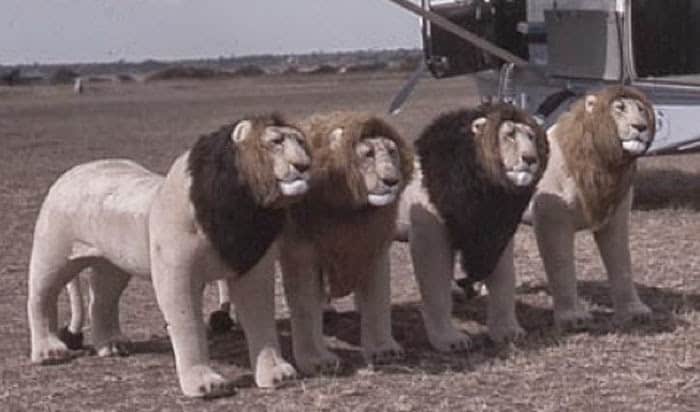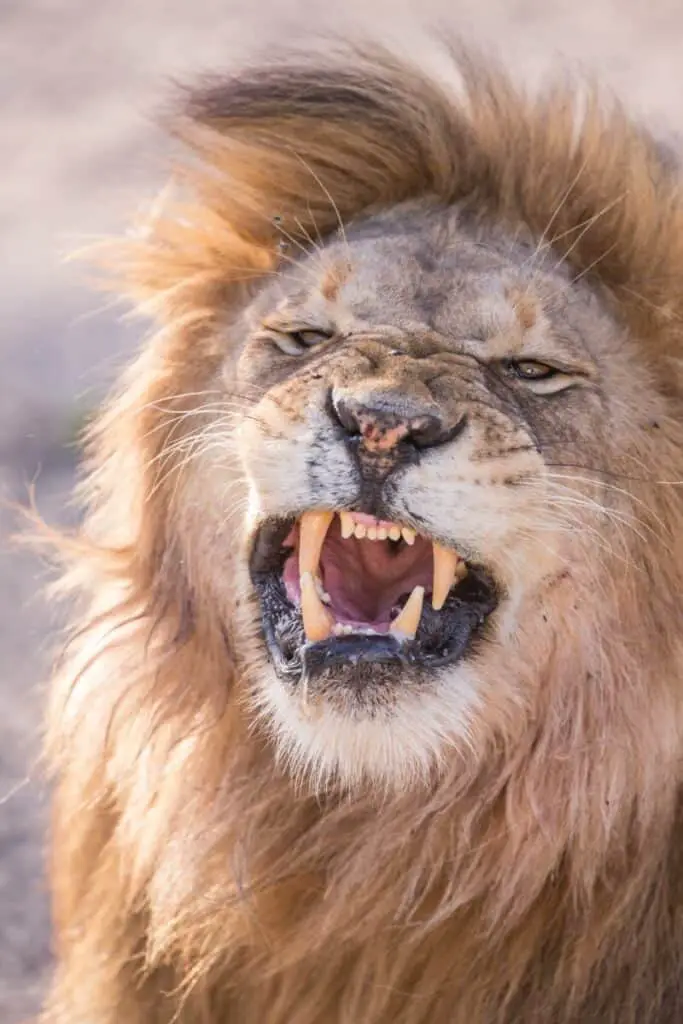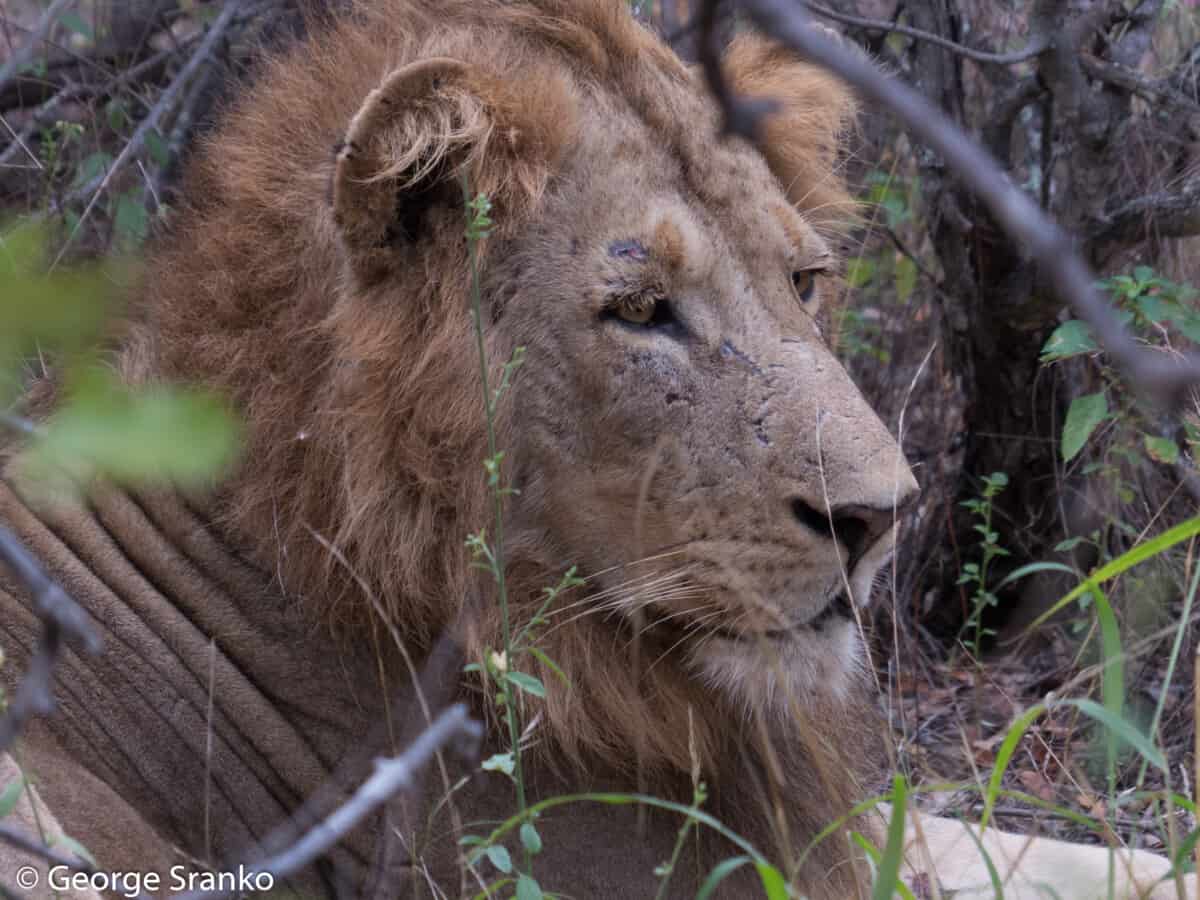Having the opportunity to view wild lions up close has been one of the top highlights in our quest to see wild creatures throughout the world. We’ve visited Africa several times and always look forward to the thrill of being in a land rover surrounded by lions sitting in the shade of our vehicle!
Lions communicate through vocalizations such as loud roars, by leaving scent markings, and through visual cues, such as the darkness of the mane. The males roar to protect their territory from competing males, to attract mating partners, and to discourage other predators. Lions communicate overall health, fighting ability, and desirability as a mate through sounds, sights, and smells.
Lions are the most social of the felines, forming matriarchal groups called “prides” that consist of females in stable social units. The typical pride consists of ten to fifteen lions, with several adult females and their offspring and up to four males. Large prides, with up to 30 individuals, have a competitive advantage in hunting and in protecting their territory.
African lions are the second largest cats in the world, after the tiger, with some males exceeding 250 kg (550 lb) in weight.
Why do Lions Have Such a Loud Roar?
The lion has the loudest roar of all the big cats. Male lions roar primarily to project their strength and dominance and to defend their territory from competing males. A lion’s roar is so loud that it can reach 114 decibels at one metre (I might ask what you are doing within 1 m of a roaring lion?) This is above the human pain threshold of 110 db and it is no surprise that we humans can hear a lion roaring up to 5 miles or 8 km away.
One of our most amazing experiences has been sleeping in a tent in lion country and hearing the lions roaring in the distance. In the morning I would ask our guides a bit nervously, “how close did the lions come during the night?” The response was always something like “not to worry, they were about 2 km over that way.”
If you’ve ever heard a lion roar nearby, you’ll know that it is more than just a sound – it is more like an energy wave that crashes over you!
I always feel an instinctive tingle of unease when I hear the roar of a lion. Instinctive, no doubt, given the generations of our ancestors who lived in Africa and had to contend with being hunted by the big cats.
(In evolutionary terms, every human alive today – of any racial background – can trace their lineage back to dark-skinned ancestors who lived in Africa roughly 100,000 years ago.)
Here’s the sound of a lion roaring – check it out! Turn up the volume!
Only Four Big Cats Can Roar
It takes a specialized physiology to be able to roar. There are only four big cats that can roar: lion, tiger, leopard, and jaguar. This is because they have a longer ligament that enables them to extend and stretch the voice box more than other species of cat, allowing them to make very loud, deep sounds.
Cheetahs, snow leopards, puma and other species have voice boxes that are more like those of common house cats, with vocalizations that sound like purrs or meows.
Roaring is a Way of Marking Territory through Sound
A male lion’s roar is a way of marking his territory and warning other males that he is willing to defend it against all intruders. Younger males, particularly in coalitions, are always looking for an opportunity to defeat a resident male and take over the pride.
Consequently, they are always listening to judge the strength of the lion behind the roar. Apparently, a lion can identify the roars and calls of up to 20 individuals, according to our African wildlife guides.
Research has shown that roaring is confined to pride males within their territories and nomadic males only start roaring when they are taking over a pride. Pride males remain silent outside of their territories.
Why is the Strength of a Lion’s Roar Important?
A strong roar is a pride male’s first line of defense against being challenged by a younger, stronger male. Prides can also roar as a group with each voice being individually distinctive. Young cubs may join in the group roar of their pride with their own little mews.
If young males perceive something unusual about the strength of a roar, they may approach to investigate any potential weaknesses in the resident male. Ultimately, after roughly three years most pride males are displaced by younger, stronger challengers.
Research has shown that females with cubs can distinguish immediately between the roars of their own resident pride males, the fathers of their cubs, and the roars of unfamiliar males that could potentially be infanticidal. Lionesses are extremely protective of their young and any successful male challenger would most likely kill all the cubs under one year old to spur the females to become sexually active.
Lions of various ages and genders have unique vocalisations using a wide range of intensities and pitch. In addition to the roar of the lion, vocalisations include purrs, snarls, meows, and hisses.
Why do Male Lions have Manes? The Importance of Visual Signals!
Biological research into the interactions between males has shown that the bigger the mane, the more intimidating he looks to other males, especially the younger ones considering their chances of defeating the pride male. The second aspect is the color or darkness of the lion’s mane. The darker the mane the more testosterone being producing, so this also acts as an intimidating factor to younger males.

Dark-maned males tend to survive longer, have higher testosterone levels, and heal up better after battles. It appears that a lion’s mane provides clues to other lions about a male’s fighting ability and desirability as a mate.
See my in-depth article explaining Why Lions Have Manes and why dark manes make males more sexy!
How do Lions Communicate using Smell?
The sense of smell plays a big role in lion communication. Females communicate their readiness and willingness to mate using pheromones and organic chemicals, particularly when they go into oestrous. A male lion can easily pick up on these signals even from a distance.
Males also use scent to mark their territories and to communicate their strength and virility. This could be considered their second line of defense against younger males willing to challenge them for the role of pride male. Males will mark their territories by urinating and clawing trees, both of which leave strong scent markers.
When a lion comes across the urine or scent of another lion, it will bare its teeth in what is called the Flehmen grimace. This can look like a snarl or threat display, but in fact has nothing to do with a threat.
Urine provides a veritable catalog of information to lions about the age, sex, sexual status, testosterone levels, estrogen levels, and the overall condition of another lion.

The Flehmen response opens an olfactory organ called the vomeronasal organ (or sometimes the organ of Jacobson) located above the palate. By sniffing deeply and making the Flehmen grimace, lions are testing the complex mixture of molecules and assessing the individual in question.
Although Flehmen is observed in both males and females, it appears to be most important to males, allowing them to determine when a female is in oestrous.
We can see that scent provides lions with a good way of evaluating the strength of males and fertility of females.
For example, a young male will use these signals to determine if he has a chance of defeating the pride male. Based on the roar and the scent they can decide whether to challenge or not. A younger male might realize that the resident male is still in his prime – strong and healthy – or he might discern that the “king of the pride” seems to be getting old, weak, and vulnerable to defeat.
How do Lions Communicate using Tactile Signals?
A typical example of a tactile communication would be the lion’s greeting ceremony. When members of a pride meet after an absence, they usually perform a ritual that begins with sniffing noses, followed by rubbing heads and brushing up against one another. The tail is usually held high during the greeting or draped over the other. Small kittens rub up against their parents’ chests and throats – and love to play with tails.
Lions are often observed piled on top of one another and licking and grooming to strengthen family bonds within the pride.
Why do African Lions form Prides?
Prides include genetically related lionesses and their cubs, without any discernable hierarchy among the females. Females in a pride will not tolerate outside females. Cubs are raised communally. Upon reaching adulthood female cubs almost always stay with the pride. Males are pushed from their maternal pride when they reach maturity at about two or three years old.
Male lions excluded from the pride become nomads and often form partnership with their brothers to create “coalitions.” Males typically spend years as nomads before fighting their way to the top and becoming residents within a pride. Research shows that this happens when males are about three to seven years old and in their prime. Males in coalitions can work cooperatively to gain and maintain breeding rights over one or more prides.
A resident male must continually assert his dominance to maintain breeding rights within a pride and faces ongoing competition from other males willing to fight to claim his position and territory.
The Biggest Natural Threat to Lions?
Scientists once believed that the communal life of prides is organized to increase their hunting success. Recent research by Dr. Craig Packer, founder of the Lion Center at the University of Minnesota, has shown that lion prides are NOT formed primarily for hunting success or for shared parenting; their complex communities have evolved to deal with what Packer calls “the dreadful enemy.”
Other lions outside of the pride are the most dreaded enemy!
Prides are under constant threat from other lions – particularly coalitions of males trying to seize control of the pride. Resident males will fight to protect the females and their progeny – often to the death. Females can also die fighting to defend their cubs. If the invading males are victorious, they will kill all the young cubs to bring the females into oestrous, so they can mate with them to propagate their own genes.
Read more…
One of the best places to see lions in the wild is Kruger National Park and the adjoining private game reserves. Read my post about our experiences in Kruger and why we consider it to be one of the best safari destinations in Africa – especially on a budget!

Learn About Startling Differences between Wolves and Wolf Dogs
If you are interested in apex predators, take a look at my article on wolves and wolf-dogs. Do packs of wild dogs act the same as packs of wolves? You might be surprised by the answer to this and many more questions, including whether or not wolf-dogs make good pets.

References
Estes, Richard D., 2012. The Behavior Guide to African Mammals: Including Hoofed Mammals, Carnivores, Primates. With Daniel Otte (Illustrator) and Edward O. Wilson (Foreword)
Grinnell J., McComb K., 2001. Roaring and social communication in African lions: the limitations imposed by listeners, Animal Behaviour, Volume 62, Issue 1, 2001, Pages 93-98, ISSN 0003-3472, https://doi.org/10.1006/anbe.2001.1735.
McComb Karen, Pusey Anne, Packer Craig, and Grinnell Jon. 1993. Female lions can identify potentially infanticidal males from their roars. Proc. R. Soc. Lond. B. 25259–64 http://doi.org/10.1098/rspb.1993.0046
Scheel D., Packer C., 1991. Group hunting behaviour of lions: a search for cooperation, Animal Behaviour, Volume 41, Issue 4, 1991, Pages 697-709, ISSN 0003-3472, https://doi.org/10.1016/S0003-3472(05)80907-8.
The Lion Center Dr. Craig Packer, Founder
Considered the world’s foremost expert on African lions, Dr. Craig Packer is a Distinguished McKnight Professor of Ecology, Evolution and Behavior at the University of Minnesota. He established the world’s first research center dedicated to the study of lions in 1986.
The Gear We Love to Travel With
We love to travel in search of exceptional wildlife viewing opportunities and for life-enhancing cultural experiences.
Here’s some of the gear we love to travel with for recording our adventures in safety and comfort:
- Action Camera: GoPro Hero10 Black
- Long Zoom Camera: Panasonic LUMIX FZ300 Long Zoom Digital Camera
- 360 Camera: Insta360 ONE R 360 – 5.7K 360 Degree Camera, Stabilization, Waterproof
- Backpack camera mount: Peak Design Capture Clip
- Drone: DJI Mini 2 (Fly More Combo)
- Water Filtration: LifeStraw Go Water Filter Bottle
- Binoculars: Vortex Binoculars or Vortex Optics Diamondback HD Binoculars (good price)
Check Out Our TOP Articles for Even More Fascinating Creatures
- How do Octopus Reproduce? (Cannibalistic Sex, Detachable Penis)
- Do Jellyfish have Brains? How Can they Hunt without Brains?
- Why are Deep Sea Fish So Weird and Ugly? Warning: Scary Pictures!
- Are Komodo Dragons Dangerous? Where Can you See Them?
- Koala Brains – Why Being Dumb Can Be Smart (Natural Selection)
- Why do Lions Have Manes? (Do Dark Manes Mean More Sex?)
- How Do Lions Communicate? (Why Do Lions Roar?)
- How Dangerous are Stonefish? Can You Die if You Step on One?
- What Do Animals Do When They Hibernate? How do they Survive?
- Leaf Cutter Ants – Surprising Facts and Adaptations; Pictures and Videos
- Irukandji Jellyfish Facts and Adaptations; Can They Kill You? Are they spreading?
- How to See MORE Wildlife in the Amazon: 10 Practical Tips
- Is it Safe to go on Safari with Africa’s Top Predators and Most Dangerous Animals?
- What to Do if You Encounter a Bullet Ant? World’s Most Painful Stinging Insect!
- How Do Anglerfish Mate? Endless Sex or Die Trying!
- How Smart are Crocodiles? Can They Cooperate, Communicate…Use Tools?
- How Can We Save Our Oceans? With Marine Sanctuaries!
- Why Are Male Birds More Colorful? Ins and Outs of Sexual Selection Made Easy!
- Why is the Cassowary the Most Dangerous Bird in the World? 10 Facts
- How Do African Elephants Create Their Own Habitat?
- What is Killing Our Resident Orcas? Endangered Killer Whales
- Why are Animals of the Galapagos Islands Unique?
- Where Can You See Wild Lemurs in Madagascar? One of the Best Places
- Where Can You see Lyrebirds in the Wild? the Blue Mountains, Australia
- Keeping Mason Bees as Pets
- Why do Flamingos have Bent Beaks and Feed Upside Down?
- Why are Hippos Dangerous? (Do They Attack People?)


